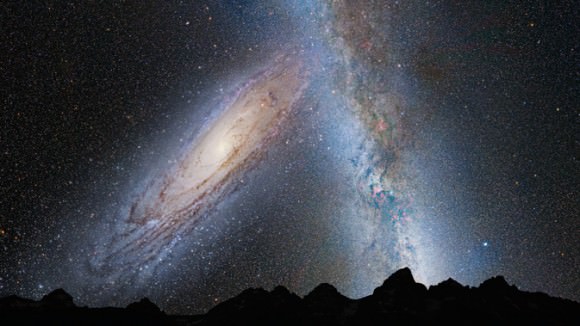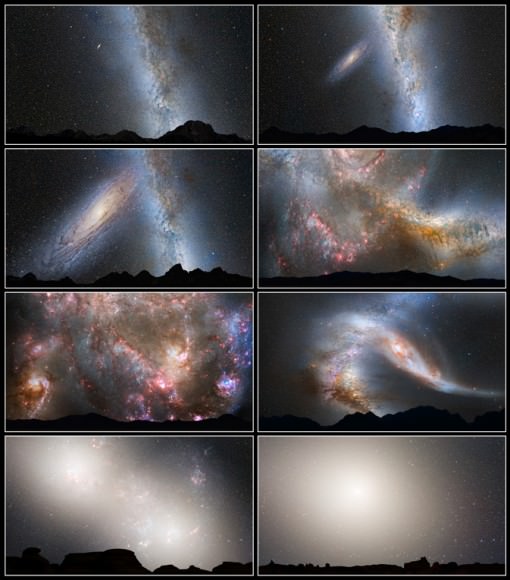
This illustration shows a stage in the predicted merger between our Milky Way galaxy and the neighboring Andromeda galaxy, as it will unfold over the next several billion years. In this image, representing Earth's night sky in 3.75 billion years, Andromeda (left) fills the field of view and begins to distort the Milky Way with tidal pull. (Credit: NASA; ESA; Z. Levay and R. van der Marel, STScI; T. Hallas; and A. Mellinger)
Astronomers have known for years that our Milky Way and its closest neighbor, the Andromeda galaxy, (a.k.a M31) are being pulled together in a gravitational dance, but no one was sure whether the galaxies would collide head-on or glide past one another. Precise measurements from the Hubble Space Telescope have now confirmed that the two galaxies are indeed on a collision course, headed straight for a colossal cosmic collision.
No need to panic for the moment, as this is not going to happen for another four billion years. And while astronomers say it is likely the Sun will be flung into a different region of our galaxy, Earth and the solar system will probably just go along for the ride and are in no danger of being destroyed.
“In the ‘worst-case-scenario’ simulation, M31 slams into the Milky Way head-on and the stars are all scattered into different orbits,” said team member Gurtina Besla of Columbia University in New York, N.Y. “The stellar populations of both galaxies are jostled, and the Milky Way loses its flattened pancake shape with most of the stars on nearly circular orbits. The galaxies’ cores merge, and the stars settle into randomized orbits to create an elliptical-shaped galaxy.”
The simulations Besla was talking about came from precise measurements by Hubble, painstakingly determining the motion of Andromeda, looking particularly at the sideways motion of M31, which until now has not been able to be done.
“This was accomplished by repeatedly observing select regions of the galaxy over a five- to seven-year period,” said Jay Anderson of STScI.
Right now, M31 is 2.5 million light-years away, but it is inexorably falling toward the Milky Way under the mutual pull of gravity between the two galaxies and the invisible dark matter that surrounds them both.
Of course, the collision is not like a head-on between two cars that takes place in an instant. Hubble data show that it will take an additional two billion years after the encounter for the interacting galaxies to completely merge under the tug of gravity and reshape into a single elliptical galaxy similar to the kind commonly seen in the local universe.
Astronomers said the stars inside each galaxy are so far apart that they will not collide with other stars during the encounter. However, the stars will be thrown into different orbits around the new galactic center. Simulations show that our solar system will probably be tossed much farther from the galactic core than it is today.
There’s also the complication of M31′s small companion, the Triangulum galaxy, M33. This galaxy will join in the collision and perhaps later merge with the M31/Milky Way pair. There is a small chance that M33 will hit the Milky Way first.
The astronomers working on this project said that they were able to make the precise measurements because of the upgraded cameras on Hubble, installed during the final servicing mission. This gave astronomers a long enough time baseline to make the critical measurements needed to nail down M31′s motion.
The Hubble observations and the consequences of the merger are reported in three papers that will appear in an upcoming issue of the Astrophysical Journal.

This series of photo illustrations shows the predicted merger between our Milky Way galaxy and the neighboring Andromeda galaxy. Credit: NASA; ESA; Z. Levay and R. van der Marel, STScI; T. Hallas, and A. Mellinger
First Row, Left: Present day.
First Row, Right: In 2 billion years the disk of the approaching Andromeda galaxy is noticeably larger.
Second Row, Left: In 3.75 billion years Andromeda fills the field of view.
Second Row, Right: In 3.85 billion years the sky is ablaze with new star formation.
Third Row, Left: In 3.9 billion years, star formation continues.
Third Row, Right: In 4 billion years Andromeda is tidally stretched and the Milky Way becomes warped.
Fourth Row, Left: In 5.1 billion years the cores of the Milky Way and Andromeda appear as a pair of bright lobes.
Fourth Row, Right: In 7 billion years the merged galaxies form a huge elliptical galaxy, its bright core dominating the nighttime sky.
HubbleSite See more images and videos here and here.
Source: Universe Today
No hay comentarios:
Publicar un comentario